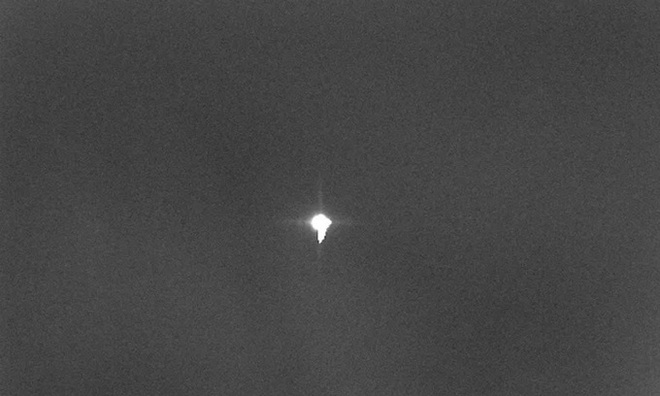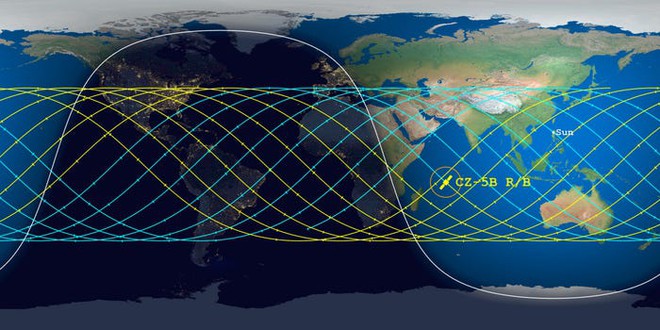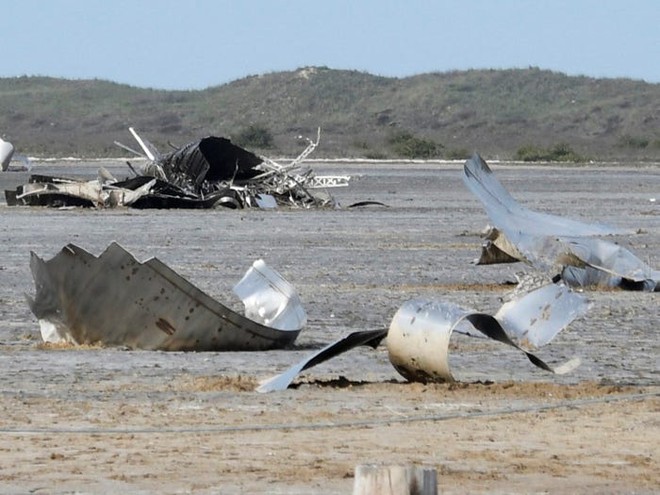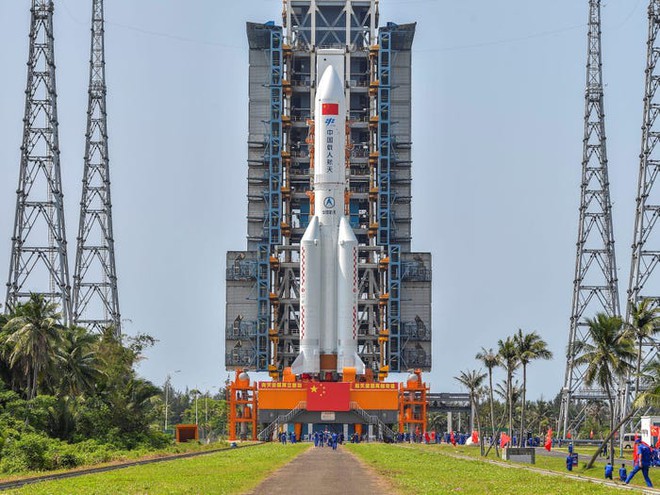The first image of a Chinese missile core that is about to fall to Earth, experts predict that the rate of hitting civilians is just like being struck by lightning.
- Tram Ho
The first image of the rocket core about to fall to Earth
A large piece of the missile launched by China on April 29 is currently orbiting the Earth and is about to fall into the atmosphere. But since this part of the missile is not controlled, it is not clear where it will return to the atmosphere or when it will fall to the ground.
Experts now believe the missile could land anywhere within 40th latitude north of the Equator.
Italian astrophysicist Gianluca Masi, who runs the Virtual Telescope Project, rocks a 0.5-second exposure photo of the Chinese missile debris using the 43 cm Paramount automatic telescope.

The core layer of Truong Chinh 5B missile falls from orbit. Photo: Gianluca Masi.
Thomas Reiter, an ESA astronaut and interdisciplinary coordinator, shared yesterday on May 7 that it is very unlikely that debris from China’s out of control missile will hit inhabited areas. . But if the missile falls near an inhabited area, the authorities will only have “very few hours” to issue a warning to everyone.
For this reason, he said, “we could say that the risk of something hitting the living area is comparable to that of someone getting struck by lightning.”
The rate of people getting struck by lightning each year in the world is only 1 in 1,200,000, according to research by the National Oceanic and Atmospheric Administration – NOAA.
However, according to this expert, since it is not clear where the missile will land until the very last moment, “unfortunately it is very difficult to give a warning to those areas, for example, if it falls on the inhabited area. “
“The advance warning will be available within hours, maybe even less,” Reiter said.

Blue and white lines represent uncertainty in the range prediction model where the Long March 5B core could fall.
The rocket core is currently traveling around the world every 90 minutes
When the core of the rocket falls through Earth’s atmosphere, friction heats the air around it to about 3,000 degrees Fahrenheit. The missile will likely break at this temperature and its parts can be vaporized. fire, but other small pieces may survive.
Experts can only estimate the missile body will plunge into Earth. A general rule of thumb is that 20% to 40% of the mass of a large body will survive falling through the atmosphere. In this case, that means an object weighing between 5 and 9 tons. It may include fuel tanks, propellants, large rocket engine parts, and metal fragments and insulation.
US Defense Secretary Lloyd Austin said the country had no plans to shoot down the remains of the Chinese missiles.
“We have the ability to do a lot of work, but we have no plans to shoot it down,” he told The Guardian. “We hope that it will land in a place where it won’t harm anyone. Hopefully in the ocean, or somewhere similar.”
He also said that the rocket is expected to fall between Saturday and Sunday. It is unclear exactly when and where.

Debris scattered near Boca Chica, Texas, USA after the explosion of an undone prototype of the Starship missile developed by SpaceX in March.
“China owes the international community an explanation”
Typically, after launch, rockets propel themselves into the atmosphere and fall back to Earth into remote oceanic regions such as the South Pacific – in a process known as “controlled re-entry. “.
Old Chinese missiles also follow this practice. But two days after Long March 5B was launched, Earth observers realized that its upper layer was orbiting the planet and slowly losing altitude. This, unlike most phases of modern rockets, suggests it has fallen into an unstable orbit. Experts aren’t sure if this was an accident, or if the missile was simply designed that way. The Chinese authorities have not given an explanation.
If any part of the missile lands in an area inhabited by people or their property, China could be liable for the damage. Under the 1972 Space Responsibility Convention, the rocket launching state is responsible for its missiles and any damage they cause.
“I hesitate to use the word irresponsible,” said John Logsdon, founder of the George Washington University Institute of Space Policy and a former member of the NASA Advisory Council, said. “I want the Chinese side to share more clearly about why this happened.”
“I’m a little confused why this happened. Is it just a deliberate disregard for international principles? Or is it a new device and not well-designed to make a trip?” What is it, unfortunately it puts many people at risk, “ he added.
“I think at a minimum, China owes the international community an explanation,” says Logsdon.

The Long March-5B Y2 missile, which carries the core module of China’s space station at the Wenchang Space Launch Center, China. Photo taken on April 23
Don’t be afraid to be missed, “unfortunately” you also have many opportunities to witness this event again
The core of the Chinese missile that is falling back to Earth is in fact just one of 11 launches that China is planning, in the process of building a new space station in orbit.
According to the China Global Television Network (CGTN), two of the country’s upcoming launches are planning to use the Long-March 5 missile. Core returns to the atmosphere this weekend.
The other eight launches used the smaller Long March-7 and Long March-2F missiles. Of which 4 will carry cargo and 4 will carry the astronauts, according to CGTN reported.
The Long March-5B is one of the largest rockets in the world designed to send something to orbit. They can carry loads up to 27 tons and measure 50 meters high and 5 meters wide when standing on the ground. As planned, it will bring modules of the Tian Cung space station into orbit.
The entire mission is set to be completed by 2023.
Refer to BI, Independent
Source : Genk
